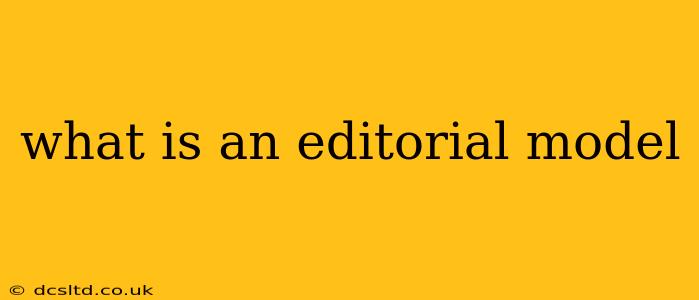An editorial model isn't just about choosing between a blog and a newsletter; it's the foundation of your content strategy. It dictates how you create, curate, and distribute content to achieve your goals—whether that's driving sales, building brand awareness, or establishing thought leadership. This comprehensive guide will explore various aspects of editorial models, answering your burning questions along the way.
What are the Different Types of Editorial Models?
There isn't one single "right" editorial model. The best approach depends on your specific needs, resources, and target audience. However, some common models include:
-
Blog-centric: This relies heavily on regularly published blog posts, often covering a range of topics within your niche. It’s excellent for organic search visibility and building a community.
-
Newsletter-driven: This focuses on email marketing, delivering curated content directly to subscribers. It's highly effective for nurturing leads and building strong relationships.
-
Social-media-first: Prioritizes creating content specifically designed for various social media platforms. This requires understanding each platform's unique audience and best practices.
-
Podcast-focused: This model utilizes audio content to connect with listeners. Podcasts allow for a more intimate and conversational approach, ideal for building strong brand loyalty.
-
Video-centric: Emphasizes video content, whether short-form (TikTok, Reels) or long-form (YouTube). Visual storytelling can be highly engaging and reach a broad audience.
-
Hybrid Models: Many organizations utilize a blend of these models, leveraging the strengths of each to reach a wider audience and achieve multiple goals.
What are the Key Components of an Effective Editorial Model?
A robust editorial model needs several key components:
-
Clearly Defined Goals: What do you hope to achieve with your content? Increased brand awareness? Lead generation? Driving sales? Your goals should guide every content decision.
-
Target Audience: Understanding your audience—their demographics, interests, needs, and pain points—is crucial for creating relevant and engaging content.
-
Content Pillars: These are the core topics or themes that consistently appear in your content. They help establish your expertise and provide a framework for content creation.
-
Content Calendar: A schedule outlining planned content, ensuring consistent publishing and efficient workflow.
-
Content Promotion Strategy: How will you get your content in front of your target audience? This might include social media marketing, SEO optimization, email marketing, and paid advertising.
-
Performance Measurement: Track key metrics (website traffic, engagement, conversions) to assess the effectiveness of your editorial model and make necessary adjustments.
How Do I Choose the Right Editorial Model for My Business?
Choosing the right model requires careful consideration. Ask yourself:
- What are my business goals?
- Who is my target audience?
- What resources do I have available (time, budget, personnel)?
- What platforms are my target audience most active on?
- What type of content am I best equipped to create?
What is the Difference Between an Editorial Calendar and an Editorial Model?
The editorial model is the overarching strategy, while the editorial calendar is the tactical implementation. The model defines what kind of content you create and why, while the calendar outlines when and how that content will be published.
How Often Should I Update My Editorial Model?
Your editorial model shouldn't be set in stone. Regularly review and update it (at least quarterly) to ensure it aligns with your evolving business goals and audience needs. Track your results and adapt accordingly.
By carefully considering these factors and regularly evaluating your progress, you can develop an editorial model that drives results and helps you achieve your business objectives. Remember, consistency and adaptation are key to success.
